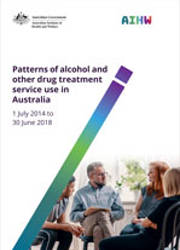Patterns of alcohol and other drug treatment service use in Australia, 1 July 2014 to 30 June 2018
Citation
AIHW
Australian Institute of Health and Welfare (2019) Patterns of alcohol and other drug treatment service use in Australia, 1 July 2014 to 30 June 2018, AIHW, Australian Government, accessed 25 April 2024.
APA
Australian Institute of Health and Welfare. (2019). Patterns of alcohol and other drug treatment service use in Australia, 1 July 2014 to 30 June 2018. Canberra: AIHW.
MLA
Australian Institute of Health and Welfare. Patterns of alcohol and other drug treatment service use in Australia, 1 July 2014 to 30 June 2018. AIHW, 2019.
Vancouver
Australian Institute of Health and Welfare. Patterns of alcohol and other drug treatment service use in Australia, 1 July 2014 to 30 June 2018. Canberra: AIHW; 2019.
Harvard
Australian Institute of Health and Welfare 2019, Patterns of alcohol and other drug treatment service use in Australia, 1 July 2014 to 30 June 2018, AIHW, Canberra.
PDF | 2.2Mb
Clients accessing alcohol and other drug treatment services across Australia commonly have multiple episodes of treatment spanning several years. This report categorises 3 client groups based on their patterns of service use between 1 July 2014 and 30 June 2018. While there were subtle differences in principal drug of concern and some aspects of service use between the 3 groups, overall there were many similarities. This highlights the complexities of characterising alcohol and other drug service users.
- ISBN: 978-1-76054-652-6
- Cat. no: HSE 239
- Pages: 36
-
Median duration of closed episodes for continual and episodic was 1.8 times higher than transitory service users.
-
Continual service users had the highest proportion of closed treatment episodes for heroin and amphetamines.
-
Transitory service users had the highest proportion of service use for cannabis.
-
Episodic service users had the highest proportion of clients who identified as Aboriginal and Torres Strait Islander.



